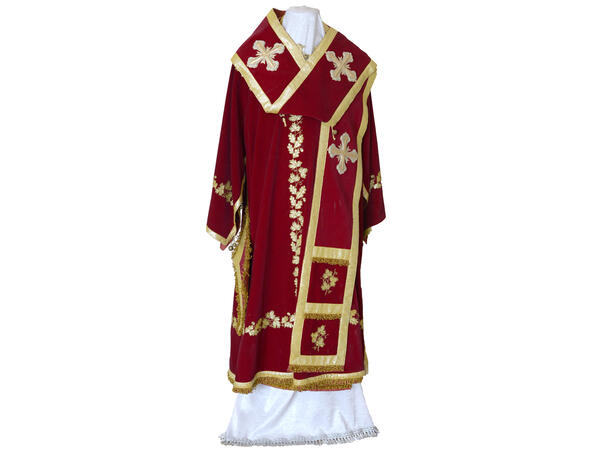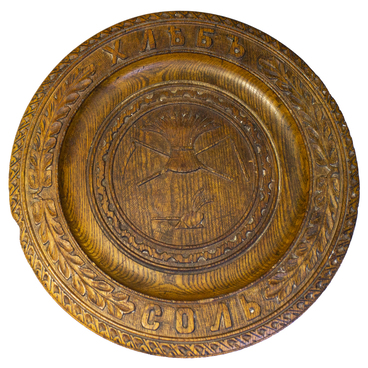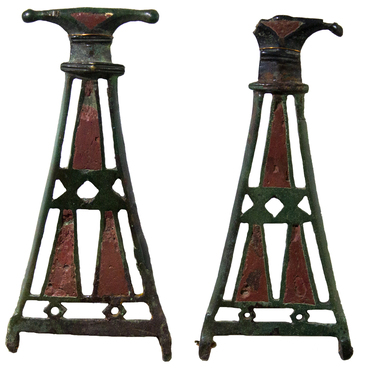The exhibition presents the ceremonial clerical vestments of archiereus, which belonged to Father Paisi. From 1988 to 2008, he managed the Oryol church department.
The complete clerical vestments of archiereus consist of ten main parts, each has its meaning. The Orthodox Church introduces regulations to all clergymen’s ranks to wear special priest vestments for committing liturgical services. By the end of the liturgy, it should be taken off and left in the church.
In Russian Orthodox Church they use vestments in seven colors: golden, white, pale-blue (blue), red, vinose (violet), green and black. According to the Russian tradition, red vestments are worn during the whole Easter period and martyr’s remembrance days.
One of the most ancient items of liturgical vestments is a sticharion — a straight, long robe with wide sleeves, that covers the whole body. In Christianity, a sticharion is considered sacred clothing beause Saviour, apostles as well as priests of the Old Testament period wore it. Historically, a sticharion was sewed only from linen and in white color only.
Bishop’s sticharion is called outer sakkos or surplice of archiereus, as sakkos is worn atop of it — sleeveless clothing, worn over the head and fastened at the sides. Translated from Hebrew it means “sackcloth”. In the Byzantine Empire sakkos was part of the Emperor’s costume. In medieval Rus, sakkos clothing appeared no later than in the 14th century. It served as a liturgical vestments of the metropolitans of Moscow. From 1705, wearing sakkos was a mandatory condition for all archiereus of the Russian Church.
Bishops was wearing on top of sakkos a special belt — omophorion. Translated from Ancient Greek it meant “bearing”. The Great omophorion is meant as a long, wide ribbon with the images of the crosses. It should be hung around the neck in a way that one end goes down on the chest and the other on the back. A small omophorion goes down on a chest with both endings, and it is stitched or fixed with buttons on the front. Many centuries before, omophorion was made of white woolen cloth and decorated with crosses.
The complete clerical vestments of archiereus consist of ten main parts, each has its meaning. The Orthodox Church introduces regulations to all clergymen’s ranks to wear special priest vestments for committing liturgical services. By the end of the liturgy, it should be taken off and left in the church.
In Russian Orthodox Church they use vestments in seven colors: golden, white, pale-blue (blue), red, vinose (violet), green and black. According to the Russian tradition, red vestments are worn during the whole Easter period and martyr’s remembrance days.
One of the most ancient items of liturgical vestments is a sticharion — a straight, long robe with wide sleeves, that covers the whole body. In Christianity, a sticharion is considered sacred clothing beause Saviour, apostles as well as priests of the Old Testament period wore it. Historically, a sticharion was sewed only from linen and in white color only.
Bishop’s sticharion is called outer sakkos or surplice of archiereus, as sakkos is worn atop of it — sleeveless clothing, worn over the head and fastened at the sides. Translated from Hebrew it means “sackcloth”. In the Byzantine Empire sakkos was part of the Emperor’s costume. In medieval Rus, sakkos clothing appeared no later than in the 14th century. It served as a liturgical vestments of the metropolitans of Moscow. From 1705, wearing sakkos was a mandatory condition for all archiereus of the Russian Church.
Bishops was wearing on top of sakkos a special belt — omophorion. Translated from Ancient Greek it meant “bearing”. The Great omophorion is meant as a long, wide ribbon with the images of the crosses. It should be hung around the neck in a way that one end goes down on the chest and the other on the back. A small omophorion goes down on a chest with both endings, and it is stitched or fixed with buttons on the front. Many centuries before, omophorion was made of white woolen cloth and decorated with crosses.



